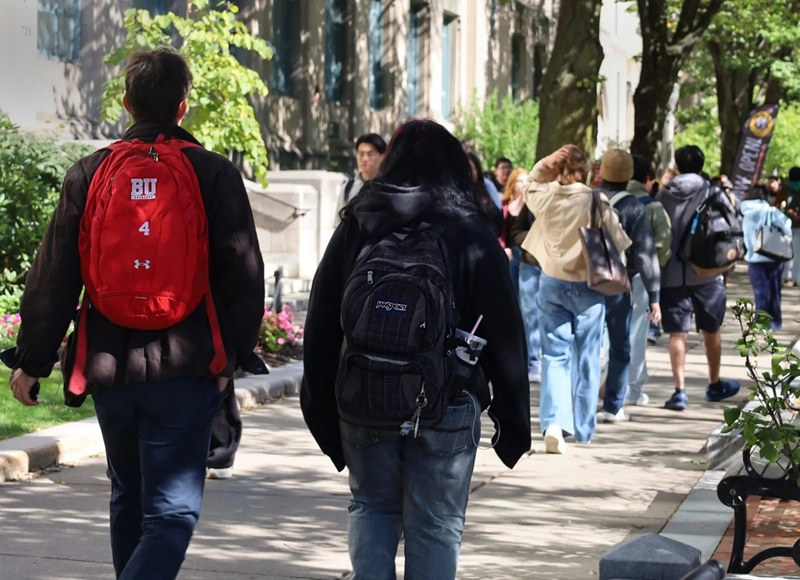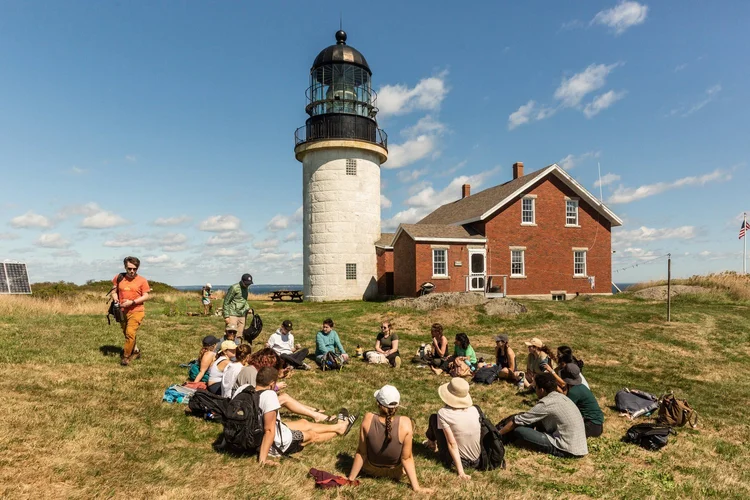Colleges need an experiential learning revolution
Massachusetts is more closely linked to higher education than any state. We should lead its innovation-fueled makeover.
by Eric Schwarz
America is falling out of love with college, and it’s not hard to see why.

Boston University students walk in front of the College of Arts and Sciences between classes in Boston. (Maria Pemberton/CommonWealth Beacon)
First, colleges are not doing enough to build purpose, confidence, agency, and maturity. Colleges are not the cause of growing anxiety and a declining sense of purpose among young people; but, faced with the reality of these trends, colleges have not changed their models nearly enough to help students build purpose, confidence, agency, and maturity.
Second, colleges are not doing enough to build “durable” or “transferable” skills and the networks and experiences students need to transition successfully from high school to 21st century careers that pay good wages.
There is a striking gap between what students and college administrators think students have learned and can do, and what employers think students can do, particularly in vital areas such as communication, critical thinking, professionalism, and leadership. For example, 81 percent of recent graduates feel they are adept at critical thinking, while only 56 percent of employers agree. Seventy-eight percent of new graduates say they are proficient at communication, while only 54 percent of employers agree.
Third, colleges cost too much. While many colleges and degrees still provide a great return on investment, many do not. Over the last 80 years, the relative portion of college costs borne by students/families, philanthropy, and the public sector has gone up and down, but the actual cost of delivering a year of college has risen sharply — at about four times the rate of inflation.
The cost today of delivering a year of college education (not including research expenses, housing, etc.) at a four-year institution ranges from approximately $25,000 to $40,000, compared to the average cost per student of delivering a year of K-12 education of about $16,000. And this is true even though K-12 students are in class for about 950 hours a year and college students are in class for about 350 hours a year.
After a career spent mostly in K-12 education, for the last decade I have partnered closely with 20 different four-year colleges and universities, including public and private, large and small, selective and not selective. Each of these institutions offer strong programs backed by committed faculty and staff. But none is doing nearly enough to address the root causes of this trio of crises – a crisis of purpose, a crisis of skills, and a crisis of cost.
The result is that American young people and their families are voting with their feet (the percentage of high school graduates choosing to enroll in college has declined from 70 percent in 2009 to 61 percent in 2023) and Americans of all ages are sharing their opinions about college, including at the ballot box.
According to Gallup, the percentage of Americans expressing “a great deal” or “quite a lot” of confidence in higher education declined from 58 to 36 percent over the last 10 years while the percent expressing “very little” or “no” confidence shot up from 10 to 32 percent.
So what should be done? And how can Massachusetts – home to America’s first public school (Boston Latin), first university (Harvard), and one of the greatest concentrations of colleges (104 colleges in a state of 7 million residents) – lead the way?
I believe we need fundamentally new models for teaching and learning and that the new models need to break the monopoly of “sage on the stage” teaching and lean into an experiential learning revolution – a dramatic increase in real-world, apprenticeship-based, internship-based, and work-based learning. We need to get students out of the classroom and out into the community.
When I was in college, I learned a lot from some very sagacious professors who lectured and led discussions in their area of expertise. But I learned much more from job and internship experiences out in the real world. My experience is not an outlier. A survey sponsored by Hult International Business School reported that 77 percent of young people entering business careers said they learned more in their first six months of work after college than they did in four years of college. Why not make college more like those first six months of work?
To be clear, I don’t think the purpose of college is just to prepare young people for work. And I do think an important role remains for “sage on the stage” instruction, including lectures, guided discussions, and liberal arts inquiry led by skilled professors. The purpose of college should include preparation for work, but also preparation of young people for a life of purpose, a life of civic leadership, and a life of critical thinking and action as citizens in a democracy, and as family and community members.
What are some new college models that could point the way forward – and that could address the three crises of purpose, skills, and cost?
A whole new type of college – an apprenticeship college – where half the credit comes from purposeful work with special projects, guided challenges, reflection, mentorship, and more. Reach University is piloting this approach with future teachers and public health workers, and College for Social Innovation, the nonprofit I lead, is exploring the creation of a two-year public service college built around four immersive public service internships as well as related courses in problem solving, human centered design, and communication.
History credits can come from studying the history of social change movements in Boston and math credits from diving deep on the use of data to explain the successes and challenges of various social impact strategies. But the internships themselves – packed with research, project management, independent learning, and mentorship – need to be credited too.
A whole new type of college that is organized around missions, not majors, and that includes deep Outward Bound-type experiences at launch, at least two immersive high-impact learning semesters that offer learning primarily outside of the traditional classroom (with full academic credit), and a requirement that every student complete a capstone project that connects to their personal and professional mission.
Colleges built around mission and purpose can build from an emerging network of “microcolleges” such as Deep Springs College in Nevada, Thoreau College in Wisconsin, and the Seguinland Institute in Maine, all supported by Springboard, a nonprofit designed to research and support small and purpose-driven learning communities.
A whole new type of college that marries AmeriCorps or other intense and well-scaffolded service experiences with deep mentoring and low-cost distance learning taken at whatever pace is desired by the learner — with degrees earned over two years or over 10 years.
This model can build on the work at Boston-based nonprofit Duet, which in partnership with Southern New Hampshire University (SNHU) enrolls low-income students to work toward associate or bachelor’s degrees, using just half of their Pell grant to pay for classes at SNHU and the other half to pay for intensive mentoring and personalized coaching from Duet.
The dramatic changes we need will require new and disruptive innovations – new “microcolleges” with the freedom to invent new approaches to higher education. But I also believe that many of New England’s current public and private universities have the potential to pivot and to build on the many superb things they are already doing while also adding substantially more real-world learning with substantially more rigorous assessment of that learning. The recent effort across Massachusetts public universities to dramatically expand work-based learning programs, supported by the Axim Collaborative, is a good start.
The challenge is to move immersive, experiential learning from the sidelines to the center and from extracurricular to curricular. A related challenge is to measure learning much more robustly in a way that marries the mastery of competencies such as storytelling, data visualization, human-centered research and design, and project management with credits and credentials.
In the future workforce, jobs that require simple research and even powerful regurgitation will be done by AI, by robots, or by low-wage labor from other countries.
Great jobs will still exist, but they will require the type of nimble problem solving that can only be learned through real-world practice and experience. Colleges need to realize that what the students are learning today is not enough anymore.
Our goal must be nothing less than a bottom-up rethinking of that period between high school and adulthood that finds new ways to build confidence and purpose, new ways to build skills and networks, and that does it for an affordable price.

I often refer to Boston as “the Silicon Valley of social innovation,” and that description has been well earned over the centuries. Now we face a new crisis around the declining efficacy of one of those innovations – higher education – and we need to lead the nation again, in an experiential learning revolution – a set of solutions that help more young people become the leaders we need and the fulfilled adults they want to become.
Eric Schwarz is the co-founder and CEO of the nonprofit College for Social Innovation and was the founding CEO of Citizen Schools. He is author of The Boston Globe best-selling book The Opportunity Equation

CommonWealth Voices is sponsored by The Boston Foundation.
The Boston Foundation is deeply committed to civic leadership, and essential to our work is the exchange of informed opinions. We are proud to partner on a platform that engages such a broad range of demographic and ideological viewpoints.
